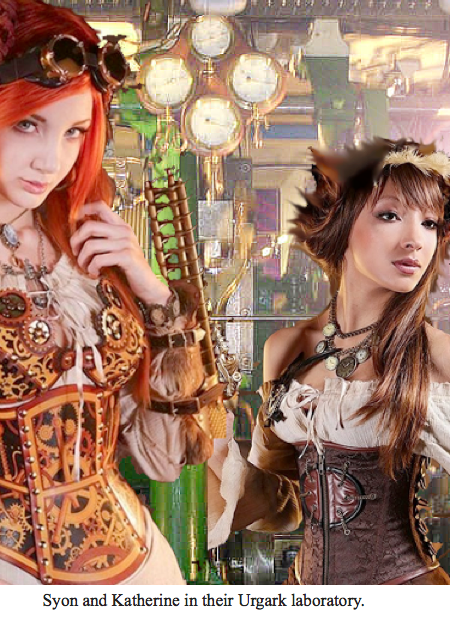 |
| Chapters in The Foundations of Eternity |
While planning some required modifications to "Design Space", I could not avoid the temptation to shift the start if the story to the minutes just before Gohrlay begins to have her brain disintegrated ("Brain Scan"). I'm a fan of starting stories at a dramatic juncture that is "in the middle if things". I started thinking of about some modifications to the story that would allow me to first insert poor Gohrlay into the destructive brain scanner and then have a "flash back" that explains her earlier life and why she "volunteered" to have the structure of her brain converted into positronic circuits.
Following that revisionist chain of thoughts, I could not avoid contemplation of how the chapter "Trysta and Merion" fits into the story. Frankly, it does not fit in very well since it is a somewhat awkward transition chapter at the end of Part I of the novel. The beginning of Part II of The Foundations of Eternity comes after a very long temporal discontinuity between the first four chapters of the story and the later events that were set in motion by Gohrlay "in the beginning".
So, I must ask, just what should be "the beginning" of the Exode Trilogy? This becomes a rather complex question in a time travel story!
 |
| Chapters in Part I of Trysta and Ekcolir |
Maybe the Exode Trilogy should start with Trysta and Ekcolir?
I originally thought that Trysta and Ekcolir would start with the capture of Fengtol, the last remaining positronic robot. I first imagined the "subtraction" of Fengtol from Earth as being a surgically precise elimination of Fengtol, but it now occurs to me that there is no need for "clean sweep" of positronics from the history of Earth...at least in the Grean Reality.
Grean is able to travel through time, so if Fengtol "makes a splash" because of the public nature of "her" demise, then such messiness can be cleaned up later. Or even "earlier", given Grean's time travel capability. One dramatic way to start the Exode Trilogy would be to have Fengtol's demise be a very public event. Imagine the fragments of Fengtol's positronic brain spread out before viewers on television.
 |
| Fanciful brain spillage from a dead robot. |
Back when I began planning the Exode Trilogy, here is the first thing I wrote in my notebook about the start of Trysta and Ekcolir: "even with Fengtol prevented from providing Earth with sedronic technology and the resulting nuclear war averted, Grean looks into the future and sees that Earth is still facing a technological disaster."
As shown in the diagram above (source), the "Grean Reality" is part of a Reality Chain that comes into existence when Grean starts using time travel technology. Actually, because of name recognition issues, I prefer to label such Reality Chain diagrams with "Asimov Reality" rather than "Grean Reality".
Trapped by the dynamics of a strange attractor, even if we Earthlings avoid nuclear war, global warming and catastrophic sea level rise will eventually catch up with us.
I've never thought much about Grean as an individual. Grean is a Kac'hin hermaphrodite and I have to eventually decide just how un-human "her" appearance is. Kach is a Kac'hin female who was shaped during her embryonic development so as to have a normal human body plan.In contrast, Grean is noticeably not a normal human of 20th century Earth.
 |
| puppet |
In addition to the issue of Grean's physical appearance there is the question of thons mind. To what extent is Grean a humanoid with free will and how much of the time is Grean simply a "puppet" for the Huaoshy, a set of hands carrying out the wishes of the Huaoshy? I want Grean to explicitly raise this question for readers of Trysta and Ekcolir. If Trysta and Ekcolir becomes the first book in the Exode Trilogy then I can keep returning to this issue, particularly in the context of Gohrlay's revolt in The Foundations of Eternity and Kach's search for the Creators in Exode.
Cognitive Modes
In Jack Vance's novel Araminta Station, Glawen slowly becomes aware of Simonetta co-Clattuc Zigonie, a former resident of the Station who departed years previously to find her fate among the stars. I particularly like this commentary on the function of Smonny's mind: "She seems to be guided by an instinctive or subconscious shrewdness, rather than formal intelligence".
Similarly, I imagine Grean as being able to function in two distinct cognitive modes: one featuring a normal humanoid consciousness and the other being "puppet mode", with a subtle subconscious influence imposed by the unseen Huaoshy.
 |
| THE MULE by Michael Whelan |
I Imagine that the Huaoshy can quietly observe Grean's on-going behavior and guide it so as to assure that Trysta and Grean will reach a satisfactory compromise on the nature of the final Reality Change. For the Huaoshy, Grean's brain is like a control panel for determining the future of Earth and the prospects for we humans.
Mind Control
Any story that introduces mind control as a plot element will risk offending readers. I'd like to reveal to readers the idea of mind control at an early point in the Exode Trilogy. I want to include several characters who have doubts about their own free will and fears about being mere puppets for the Huaoshy. At times, Gohrlay, Kach and Grean all worry about being subjected to telepathic mind control.
 One of the most annoying reading experiences of my life was grinding through Philip José Farmer's To Your Scattered Bodies Go. I've never been able to decide what was most annoying, 1) the relentlessly dualistic premise that humans have two parts, a physical body and a "wathan" or 2) the idea that there were otherwise stupid and bumbling aliens who could manufacture replacement human bodies as hosts for the wathans that carried the memories of dead humans.
One of the most annoying reading experiences of my life was grinding through Philip José Farmer's To Your Scattered Bodies Go. I've never been able to decide what was most annoying, 1) the relentlessly dualistic premise that humans have two parts, a physical body and a "wathan" or 2) the idea that there were otherwise stupid and bumbling aliens who could manufacture replacement human bodies as hosts for the wathans that carried the memories of dead humans.Farmer enjoyed writing fantasy stories in which he could combine real figures from history with fictional characters. His silly methods for dressing up his stories in the guise of science fiction simply did not work for me. Had he been born after fantasy became a better paying genre, I doubt if he would have bothered to present his stories as science fiction.
I've previously described my preference for a less magical science fiction plot device as an alternative to the "wathan". I certainly want to avoid annoying readers of the Exode Trilogy by teasing them about the Creators and mind control and leaving them in constant doubt about the free will of the characters in the story.
I found it hard to care about the characters in Riverworld...they just seemed like a jumble of puppet-like characters in some computer game...simply restart the game and you can play out their fates along a different plot arc.
This is a danger in time travel stories too. Why care about the characters when the author of the story can, upon a whim, go back in time and change everything that happens in a character's life?

Exode, the final book of the Exode Trilogy, puts an end to such time travel worries since the Huaoshy have by that point changed the dimensional structure of the universe so as to make time travel impossible. Is there an equally effective antidote to reader doubts about mind control puppetry?
Pod People
For the Hollywood folks who think "science fiction" means "horror", it can be profitable to trigger the human aversion that is experienced when something has human form but alien behavior.
One of my goals in the Exode Trilogy is to parade before readers a collection of non-human characters while usually allowing the aliens and robots to seem quite human.
The Exode Trilogy character that I want to come closest to having some zombie-like behavior is Syon. When the Pla pay attention to Syon it is important that they see "her" as a rather simple robot without interesting behavior. However, the reader will have the pleasure of knowing that Syon is a sophisticated artificial life form.
Grean knows that the Kac'hin were created with the intent that they function to allow efficient interactions between humans and the Huaoshy. However, Grean has never experienced any conscious communication or contact with the Huaoshy.
 While on Earth and working to find a viable future for we humans, Trysta challenges Grean and demands to know why Grean does the bidding of the alien Huaoshy. Trysta, as an Asterothrope, is not particularly alarmed by Grean's physical appearance, but Grean's devotion to the unseen aliens annoys Trysta.
While on Earth and working to find a viable future for we humans, Trysta challenges Grean and demands to know why Grean does the bidding of the alien Huaoshy. Trysta, as an Asterothrope, is not particularly alarmed by Grean's physical appearance, but Grean's devotion to the unseen aliens annoys Trysta.Grean's "odd and annoying" behavior arises from the fact that "she" is all too aware of the fact that technology-wielding humans have a real knack for self-extermination.
During training for a mission on Earth, Grean spent many years trying to view alternative Realities in which humans could successfully spread a technological civilization between the stars. It is only after having the chance to reside on Earth and work with Trysta that any glimmers of hope for a happy human future begin to appear.
 |
| at Urgark |
Freak out
If I'm willing to have Fengtol spill her brains on live TV, then why not also let the viewing public see Grean? I'm imagining that Grean has distinctive Asterothrope features such as very long fingers. Maybe Kac'hin hermaphrodites, like Asterothrope hermaphrodites, should also have small bodies.
When Fengtol realizes that "she" has been lured into a trap, she might decide to move into a very public place in hope of forcing Grean to give up pursuit. If the first televised baseball game was in 1939 then I should be able to let Fengtol suffer a dramatic "death" on live TV with Grean seen in hot pursuit of the robot.



























































